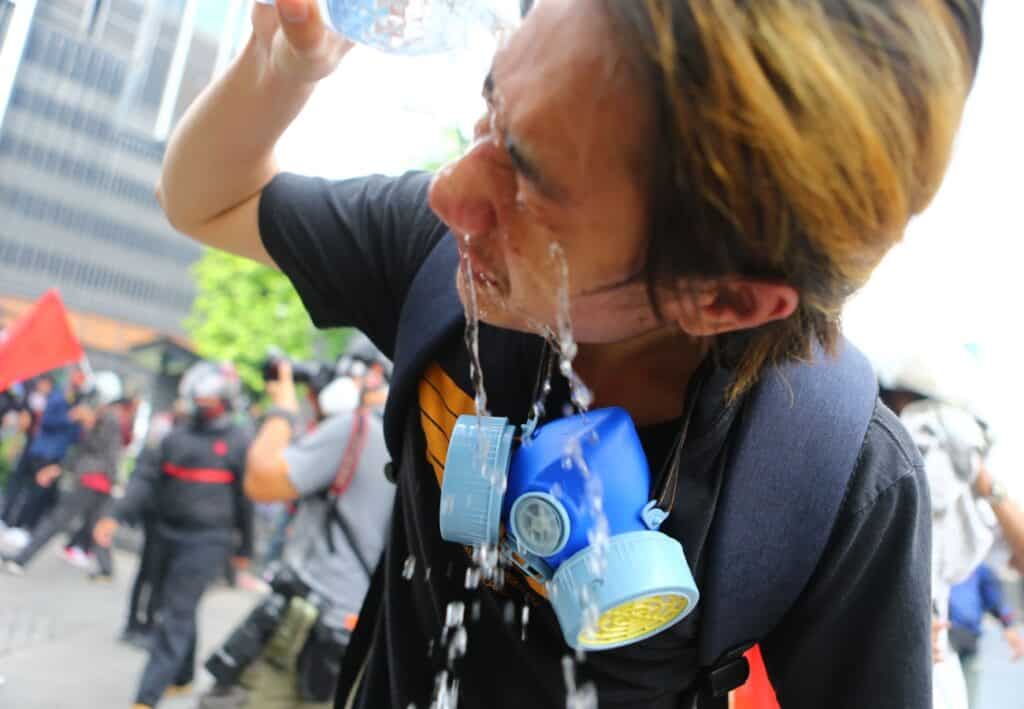A Guide to Tear Gas Survival: Lessons from a Military Trainer
Civil unrest and protests across the country are being met with tear gas and batons. We have all seen the video footage online and on television. If you found yourself caught up in a protest that turns violent or chaotic, and tear gas fills the air would you know what to do?
I was watching Danielle Guldin on TikTok, a former military chemical weapons expert who trained soldiers on how to respond to various chemical attack scenarios, describe in detail what you should do if hit by tear gas. This was the most in-depth overview of something I hope never to need. She added some very important details to the general instructions laid out below. I will post the original TikTok at the bottom of this article – it’s worth a listen.
Here are the basics.
What is Tear Gas?
Tear gas refers to a variety of chemical compounds that are used as riot control agents. These substances are not true gases under normal conditions; they are liquids or solids that can be finely dispersed in the air, often through sprays, fog generators, or grenades and shells. The term “tear gas” is somewhat of a misnomer, as these compounds are typically aerosolized solid or liquid chemicals, not gaseous substances.

What is Tear Gas Used For?
The primary purpose of tear gas is to temporarily incapacitate individuals by irritating the mucous membranes, resulting in a stinging sensation in the eyes, tears, coughing, choking, and general discomfort. The most commonly used compounds in tear gas are chlorobenzylidenemalononitrile (CS) and chloroacetophenone (CN), synthetic organic halogen compounds. Another common agent is oleoresin capsicum (OC), or pepper spray.
How Does Tear Gas Affect The Body?
When dispersed, tear gas irritates the eyes, nose, mouth, and lungs, causing symptoms such as tearing, involuntary closing of the eyelids, itching, burning, temporary blindness, blurry vision, and chemical burns in the eyes. It can also cause respiratory and gastrointestinal symptoms like choking, burning and itching of the nose and throat, trouble breathing, coughing, salivating, chest tightness, nausea, vomiting, and diarrhea.
Skin contact with tear gas can lead to irritation and pain, and in some cases, prolonged or repeated exposure can cause symptoms of post-traumatic stress disorder (PTSD), increased heart rate or blood pressure, and even cardiac arrest or death in individuals with preexisting heart conditions.
How Long Do The Symptoms of Tear Gas Last?
The effects of tear gas are usually temporary, and most people recover without long-term effects. However, the severity of symptoms can be exacerbated by factors such as the concentration of the agent, duration of exposure, and whether exposure occurs in an enclosed space. It is important to note that while tear gas is intended for temporary incapacitation, there is a risk of serious permanent injury or death, particularly if the canisters are fired directly at individuals or used in confined spaces.
Protective Clothing and Gear
- Cover Your Skin: Wear long sleeves, pants, and gloves to minimize skin exposure to tear gas.
- Eye Protection: Use shatter-resistant goggles or a full-face gas mask. Regular sunglasses or prescription glasses are not sufficient as they do not provide a seal around the eyes.
- Respiratory Protection: A gas mask is ideal, but if unavailable, use a wet bandana or a respirator mask designed to filter out particles.
- Avoid Contact Lenses and Makeup: Do not wear contact lenses as they can trap irritating chemicals beneath them. Also, avoid wearing makeup as it can absorb tear gas.
Additional Precautions
- Do Not Pick Up Tear Gas Canisters: These can be extremely hot and might still be active, posing risks of burns or explosion.
- Carry Water: Always have water with you, not only for hydration but also to rinse off any chemicals you might come into contact with.
- Prepare for Identification and Arrest: Carry identification and emergency contact information written on your arm in permanent marker, in case you are detained.

Steps To Take In Immediate Response to Tear Gas Exposure
Tear gas, a common riot control agent, can cause severe discomfort and health issues upon exposure. If you find yourself affected by tear gas, it’s crucial to act quickly and follow these evidence-based steps to minimize harm and alleviate symptoms.
Step 1: Move to Fresh Air
Immediately leave the contaminated area and seek fresh air. Avoid touching your face, and try to stay calm to reduce the inhalation of the gas.
Step 2: Avoid Rubbing Your Eyes
Resist the urge to rub your eyes, as this can exacerbate irritation. If exposed to the gas, your hands may also be contaminated, and rubbing can introduce more irritants into sensitive areas.
This may be the most difficult step to follow. Your eyes will burn, and you will feel compelled to rub your eyes. THIS WILL MAKE IT WORSE! Resist at all costs.
Step 3: Hand Washing
Before touching your face or eyes, thoroughly wash your hands and arms with soap and water to remove any tear gas particles.
Step 4: Remove Contact Lenses and Glasses
If you wear contact lenses, remove them immediately after washing your hands. Discard the lenses as they cannot be reused. If you wear glasses, remove and clean them thoroughly with soap and water before wearing them again.

Step 5: Rinse Your Eyes
Flush your eyes with water or saline solution for 10 to 20 minutes. Pour the fluid from the inner corner of the eye outward, ensuring the contaminated water does not run over other parts of your face or skin.
Step 6: Cleanse Your Face and Skin
Use a wet cloth to wipe your face, then wash with soap and water. Be careful to wipe away from the eyes, nose, and mouth to prevent further contamination. If your skin is irritated, you may wash the affected areas with baby shampoo and water.
Step 7: Decontaminate Clothing
Remove any clothing that may have been exposed to tear gas, being careful not to pull contaminated clothing over your head. Cut off clothing if necessary. Undress outside if necessary, as the gas particles can get on towels and bathroom surface areas. Seal the contaminated clothing in a plastic bag for proper disposal or decontamination.
Step 8: Shower
Take a cold shower to rinse off any remaining tear gas particles. Hot water can open your pores and increase the absorption of the chemicals, leading to more irritation. Do not take a bath, as soaking in water can cause re-exposure to the chemicals. When showering, start by bending over and letting the water run through your hair away from your body. Do not let contaminated water get onto your genital region.
Step 9: Seek Medical Attention
If symptoms persist or if you have pre-existing health conditions, especially respiratory issues, seek medical attention immediately. Health professionals can provide further treatment and monitor for any complications.
Step 10: Ventilate the Affected Area
If the exposure occurred indoors, ventilate the area thoroughly. Open windows and use fans to clear out any lingering tear gas particles.
Step 11: Professional Cleanup
Professional cleaning services may be necessary for property affected by tear gas to remove residue and prevent long-term contamination. These services have the expertise and equipment to safely decontaminate the area.
Conclusion
Tear gas exposure can be distressing and harmful, but prompt and proper action can significantly reduce its impact on health. Always prioritize moving to a safe location and decontaminating yourself as quickly as possible. Remember that while most symptoms are temporary, medical advice should be sought if discomfort continues or if you have underlying health conditions.
Watch The TikTok Overview by Danielle Guldin
@sanfranica @Blackpowderpress Former military chemical weapons expert describes in depth how to deal with tear gas. More useful info that was put out during the George Floyd rebellion in 2020. @danielleguldin
♬ original sound – Elieth 🍉🇵🇸




